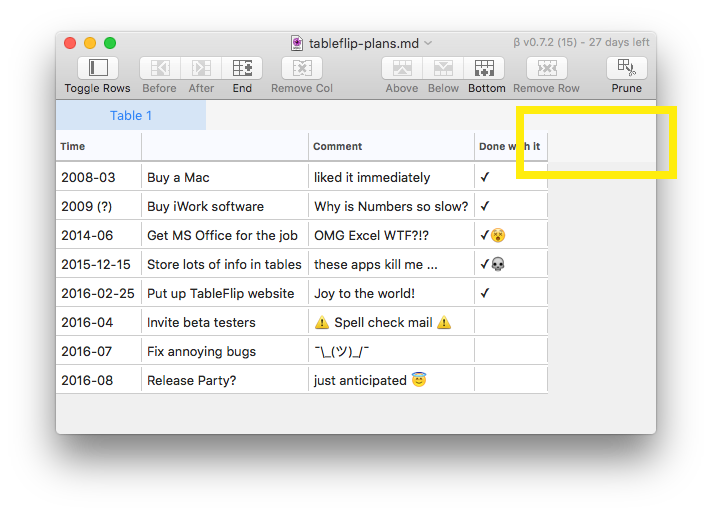Transparent NSTableView Headers
An NSTableView is usually embedded in a NSScrollView. If you set the columns not to span the full width, the two of them will take care of drawing an empty table header cell to the right so that the interface doesn’t look weird.
But I want to have a weird interface. Because TableFlip’s tables are different than the usual NTableView use cases.

Now it should be even easier to see that the header cells are still part of the table and not just a block of color in the interface.
The first step is to make your NSTableHeaderView not draw full width but only existing column headers:
class NarrowTableHeaderView: NSTableHeaderView {
override func drawRect(dirtyRect: NSRect) {
guard let columns = tableView?.numberOfColumns
else { return }
(0...columns)
.map { headerRectOfColumn($0) }
.forEach { super.drawRect($0) }
}
}
I am using a NSVisualEffectView on the window so this looks odd. If you don’t use a blur effect, the background color will match the default window’s color and you’ll be done.

You’ll notice that the content section of NSScrollView doesn’t draw a background while the header section draws the default background to the right of the header. That’s because NSScrollView uses two NSClipViews for what it does. One is the contentView and it behaves properly. The other is privately used for the header section and ignores the NSVisualEffectView setting. Probably because it is commonly used to draw something anyway.
To make the header clip view look truly transparent in a setup like mine, you have to add another NSVisualEffectView to the:
class TransparentHeaderScrollView: NSScrollView {
override func awakeFromNib() {
super.awakeFromNib()
transparentizeHeaderClipView()
}
private func transparentizeHeaderClipView() {
let clips = self.subviews.flatMap { $0 as? NSClipView }
guard let headclip = clips.filter({ $0 !== self.contentView }).first,
content = headclip.documentView as? NSView
else { return }
let visualEffectView = NSVisualEffectView(frame: NSRect.zero)
visualEffectView.material = NSVisualEffectMaterial.Light
visualEffectView.blendingMode = NSVisualEffectBlendingMode.BehindWindow
visualEffectView.state = NSVisualEffectState.Active
headclip.documentView = visualEffectView
visualEffectView.addSubview(content)
}
}
That does the trick.